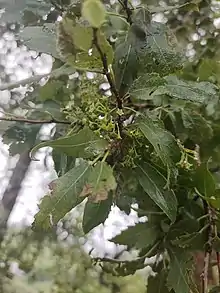| Anisoplaca acrodactyla | |
|---|---|
.jpg.webp) | |
| Scientific classification | |
| Domain: | Eukaryota |
| Kingdom: | Animalia |
| Phylum: | Arthropoda |
| Class: | Insecta |
| Order: | Lepidoptera |
| Family: | Gelechiidae |
| Genus: | Anisoplaca |
| Species: | A. acrodactyla |
| Binomial name | |
| Anisoplaca acrodactyla | |
| Synonyms[2] | |
| |
Anisoplaca acrodactyla is a species of moth of the family Gelechiidae.[1] It was described by Edward Meyrick in 1907 and is endemic to New Zealand. This species has been observed in South Island as well as in the North Island. Larvae feed on species in the genera Hoheria and Plagianthus including the species Plagianthus regius'.
Taxonomy

This species was first described by Edward Meyrick in 1907 and named Gelechia acrodactyla.[3][2] Meyrick used three specimens collected in native forest in Invercargill by Alfred Philpott.[3] In 1915 Meyrick placed this species within the genus Anisoplaca.[4] In 1928 George Hudson described and illustrated this species.[5][2] John S. Dugdale confirmed the placement of this species in the genus Anisoplaca in 1988.[2] The male lectotype specimen, collected at Invercargill, is held at the Natural History Museum, London.[2]
Description
Edward Meyrick described this species as follows:
♂. 15–17 mm. Head whitish-ochreous. Palpi ochreous-whitish ; basal joint, lower third of second joint, and subapical ring of terminal joint dark fuscous. Antennae serrulate, pubescent, pale ochreous dotted with dark fuscous. Thorax whitish-ochreous, tinged or irrorated with brownish. Abdomen grey. Forewings elongate, narrow, costa gently arched, apex obtuse, termen rounded, rather strongly oblique ; whitish-ochreous, irregularly irrorated with brown ; plical and first discal stigmata rather large, blackish, plical rather before first discal ; brown irroration forms a suffused costal patch beyond middle, and a narrow terminal fascia ; cilia whitish-ochreous, with dark-grey subbasal line. Hindwings over 1, grey ; cilia, pale whitish-ochreous, with, grey subbasal line.[3]
Distribution
This species is endemic to New Zealand.[3][6] It is known from the North and South Island and has been observed at its type locality of Invercargill as well as in Dunedin, Wyndham, Banks Peninsular and in the area around the Homer Tunnel.[5][7][8]
Behaviour
The adults of this species are on the wing in November and December.[5]
Host species

The larvae of A. acrodactyla feed on the fruit of Plagianthus regius and adult moths have been reared from larvae feeding on species in the genera of Plagianthus and Hoheria.[9]
References
- 1 2 Gordon, Dennis P., ed. (2010). New Zealand inventory of biodiversity: Kingdom animalia : chaetognatha, ecdysozoa, ichnofossils. Vol. 2. p. 458. ISBN 978-1-877257-93-3. OCLC 973607714. OL 25288394M. Wikidata Q45922947.
- 1 2 3 4 5 John Stewart Dugdale (23 September 1988). "Lepidoptera - annotated catalogue, and keys to family-group taxa". Fauna of New Zealand. Department of Scientific and Industrial Research. 14: 80. doi:10.7931/J2/FNZ.14. ISSN 0111-5383. Wikidata Q45083134.
- 1 2 3 4 Edward Meyrick (June 1907). "Notes and descriptions of Lepidoptera". Transactions and Proceedings of the New Zealand Institute. 39: 117–118. ISSN 1176-6158. Wikidata Q110404133.
- ↑ E. Meyrick (12 July 1915). "Revision of New Zealand Tineina". Transactions and Proceedings of the New Zealand Institute. 47: 208. ISSN 1176-6158. Wikidata Q63123349.
- 1 2 3 George Vernon Hudson (1928), The butterflies and moths of New Zealand, Illustrator: George Hudson, Wellington: Ferguson and Osborn Limited, pp. 258–259, LCCN 88133764, OCLC 25449322, Wikidata Q58593286
- ↑ "Anisoplaca acrodactyla (Meyrick, 1907)". www.nzor.org.nz. Retrieved 2022-05-15.
- ↑ W George Howes (September 1946). "Lepidoptera collecting at the Homer, with descriptions of new species". Transactions and Proceedings of the Royal Society of New Zealand. 76: 139–147. ISSN 1176-6166. Wikidata Q62091906.
- ↑ Hamish J. H. Patrick; Mike H. Bowie; Barry W. Fox; Brian H. Patrick (2011). "The moths of Quail Island (Ōtamahua): a faunal comparison of an island under restoration with other sites on Banks Peninsula". New Zealand Natural Sciences. 36. doi:10.26021/583. ISSN 0113-7492. Wikidata Q97665452.
- ↑ "Anisoplaca acrodactyla". plant-synz.landcareresearch.co.nz. Retrieved 2022-05-15.